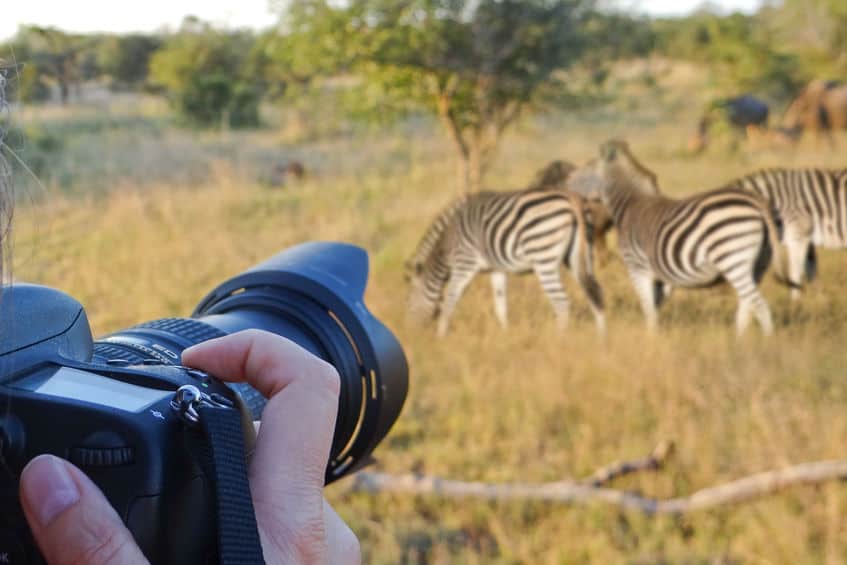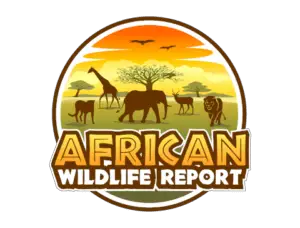This post contains affiliate links. If you choose to use them, we earn a commission.

Bringing a good camera with you on your safari is great. It allows you to capture some of those incredible and unique experiences you will have so you can look back and remember the great times you had. I have written this article to help you find a great camera at a good price so you can bring home some excellent photos from your safari.
Of course, you can just go out and spend thousands of dollars on a camera from a well-known brand and be fairly sure that you get great quality for your money but that is not really necessary. You can find some excellent cameras at a very reasonable price. The gear I personally tend to use is not necessarily the most expensive but I do prioritize high quality and durability as this will improve the overall experience and often even save money in the long term.
Everybody has different preferences when it comes to gear and if what I recommend in this post is not exactly what you are looking for, you can also see a bunch of similar cameras you may like more by following the links in this post.
These are the Best Cameras For Your Safari
I have picked what I see as the top choices for cameras in three different categories to bring on your safari here. Before you choose what to buy, I recommend that you read the rest of the article as I have covered some differences between the three categories as well as some features you should know about. Keep in mind, I have not just picked the most expensive cameras I could find. My goal is to provide you with my suggestions for the best cameras at a good price. Value for money without compromising quality has been my priority as that is how I personally prefer to purchase equipment.
Best compact camera – The Canon Powershot G9 seems to be the perfect entry-level compact camera. Both the image quality and the battery life are great. On top of that, it is slim which makes it perfect for carrying around. If you are willing to spend a bit more, the Fujifilm X100V is a solid choice in this category. It provides excellent image quality and a great overall experience. The design is beautiful and smooth and the camera itself is very lightweight which makes it easy to carry around. On top of that, you can shoot 4K video at 30 fps which is also a great feature to have when you are looking at wildlife.
Best mirrorless camera – Canon EOS M50 is one of the best mirrorless cameras at its price level. For that amount, you get super-fast and accurate autofocus (which is great for safaris when photographing moving animals), high resolution, and incredible color and details.
Best DSLR camera – In this category, Canon EOS Rebel T7 is a winner. It is an excellent starter camera that takes nothing short of amazing photos even in difficult conditions. The autofocus is good and the colors are detailed and clear. It is durable and will last you for a long time. If I was to purchase a new camera today, this would definitely be the one.
You may have noticed that I tend to recommend Canon cameras but that is simply because Canon is a huge and well-known brand that makes some great-priced cameras without compromising quality. With Canon, you know what you get. And what you get is great quality at a good price.

Before Selecting a Camera
Before you buy a camera, there are a couple of important things to consider.
Forget the technical specs for a minute. If you do not get a camera you are happy to carry around and use, you are not going to want to use it and it will end up just being a waste of space and money. The best camera is the one that is with you. Buy a camera that you are willing to carry around.
Another important thing to consider is your budget. You should not go out and spend more than you can afford on a camera. A camera is meant to be a fun thing to buy and use and should not put you in debt. You should, however, also not just buy the cheapest option you can find as you will not only miss out on quality and durability but also on some key features. More on these features in a bit.
Lastly, consider the purpose of your purchase. There are cameras out there for every imaginable purpose and what you should buy depends on what you are planning on using it for. In this article, I will focus on cameras for safaris, meaning cameras that will do well at wildlife and nature photography under different conditions.
First, let’s take a look at some different types of cameras.
Three Types of Cameras
The three types of cameras I recommend you consider for a safari are compact, mirrorless and DSLR.
- Compact cameras
- Are smaller and more lightweight which is great for bringing them with you anywhere. They generally have less zoom and lets less light in. They are not necessarily much better than a smartphone camera and are generally aimed at the more casual photographer who wants to take simple day-to-day photos but who are not necessarily trying to do professional photography.
- Mirrorless cameras
- Are similar to DSLRs (which is up next) and usually provides excellent image quality but as the name indicates, the mirror has been removed. As a result of removing the mirror, they can be made smaller and more lightweight than DSLRs which is nice, however, they are generally not as good as autofocusing as DSLRs are which is an extremely useful feature when photographing wildlife. In addition to this, the battery life is generally not as good as in DSLR cameras.
- DSLR
- Use a reflex mirror that reflects light into the optical viewfinder, allowing the photographer to capture the exact image they see when they look through the viewfinder. DSLR cameras can fit bigger lenses and therefore provide better zoom capabilities. DSLR cameras generally offer great image quality, great autofocus, and better battery life than other types of cameras. They are generally larger and heavier than mirrorless and compact camera bodies. In my opinion, this is not an issue for a safari as you spend most of your time inside a car anyway. DSLR cameras are often used on a more professional level than the two previous types I wrote about.
Now, let’s have a look at some important features to know about when selecting a camera.

Features to Look For in a Camera for Your Safari
- Resolution – The resolution essentially determines how large a photo is. It is measured in pixels (usually megapixels meaning a million pixels). This is especially important if you plan on making a print of your images. The higher resolution, the larger the image and the larger your print can be without compromising sharpness.
- Durability – Make sure you get a camera that is durable and will not break if you happen to drop it. This will save you a tremendous amount of trouble (and money) in the long run.
- Video – Pretty much all cameras these days are capable of capturing video. Some can even capture video in 4K resolution. If you plan on doing so, the resolution is not the only factor to consider. Framerate is just as important. The most normal framerate is 24 or 30 fps but some even go as high as 60 fps which gives you an extremely smooth looking video. Just make sure you don’t get a camera with 15 fps if you plan on shooting videos.
- Good Microphone – This one is only really relevant if you plan on shooting videos but if you do so, a good microphone will make the experience much nicer.
- Long battery life – When you are out on a game drive, the last thing you need is for your camera’s battery to die so make sure you get a camera with good battery life. Perhaps even get a spare battery or two.
- Price – Always make sure you stick to your budget when buying a camera. Cameras and photography are fun but should not put you in financial trouble. But do not spend too little either. Price and quality do not always go hand in hand but they do often rhyme.
- Aperture – Measured in F/STOP (looks like f/2, f/4, etc.), the aperture is essentially the size of the opening of the lens in your camera. Aperture controls the depth of field. A smaller number means less focus in front of and behind your target and a higher number means more. If for instance, you want a photo with an animal in focus and the surroundings not in focus, use a smaller aperture number. If you want both the animal and the background or for instance, a tree in the foreground and a mountain in the background to be in focus, use a higher aperture number.
- ISO – The sensitivity of your camera’s sensor. A higher number means more sensitivity to light. When you are outside during the day where there is a lot of light, you want to use a lower ISO. If you are out on an early morning or late evening game drive when it’s dark outside, you may want to use a higher ISO.
- Shutter speed – The amount of time (measured in seconds) that your shutter is open. It can look like 1/8000, 1/100, or even go up to 30 seconds. The shutter speed also controls the motion blur. A slower shutter speed means more motion blur. This can be nice when taking pictures of the night sky. A faster shutter speed means less motion blur and is useful when photographing moving targets such as African wildlife.

